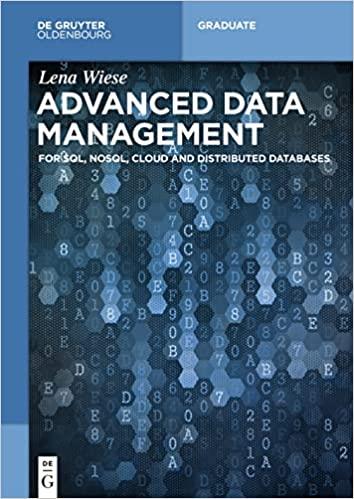Question
An Erdos-Renyi random graph G(n,p) is generated by two parameters n: the number of vertices. p: a number in [0,1], which is the probability that
An Erdos-Renyi random graph G(n,p) is generated by two parameters
n: the number of vertices.
p: a number in [0,1], which is the probability that each of the n(n-1)/2 edges is independently included in the graph.
You can check wiki for more details.
Generating a random graph. Write a function to generate a random graph given n and p.
Input: an integer n>1 and real number p in [0,1]
Output: an undirected graph G. You can use whatever format to store the graph (e.g., adjacency list or matrix).
Hint: Initiate G to be an empty graph (no edges). For each i Computing the size of the largest connected component. Given a graph G and a threshold t, write a function to test whether G contains a connected component of t vertices or more. Input: a graph G and and a number t Output: 1 if G contains a connected component of t vertices or more; 0 otherwise. Hint: One solution is the following. For each vertex, you can compute the number of vertices in its connected component by BFS or DFS. Then, the function returns 1 if there exists a vertex whose connected component has at least t vertices. There are much faster ways to do this using BFS or DFS. Please test your code thoroughly! A lot of students double-count the nodes, ending up with incorrect component sizes, sometimes even with components larger than the number of nodes in G, which is impossible. To test this, return a list of all the nodes in a connected component (not just its size), and then make sure that no node appears in your list twice, and that the number of nodes in the list equals the size of the component which you computed. Testing your algorithm on randomly generated graphs. Let n = 40. For each c in [0.2,3.0] with step size 0.2, let p=c/n, generate 500 random graphs G(n,p) using your function for step 1. Use your function for step 2 to calculate the percentage of graphs (out of the 500 graphs with the same c) whose largest connected component has at least t=30 vertices. Output: a graph where the x-axis is c and the y-axis is the percentage. As c increases, more and more graphs should have large components, since they have more and more edges. Hint: The total number of graphs you should generate is 500*15---there are 15 different c's and for each c you should generate 500 graphs. Note that the percentage is calculated for each c.
Step by Step Solution
There are 3 Steps involved in it
Step: 1

Get Instant Access to Expert-Tailored Solutions
See step-by-step solutions with expert insights and AI powered tools for academic success
Step: 2

Step: 3

Ace Your Homework with AI
Get the answers you need in no time with our AI-driven, step-by-step assistance
Get Started


